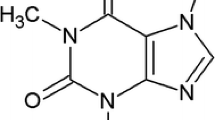Abstract
The present work is an investigation of the preferential solvation of vitamin C in five solvent mixtures: ethanol (1) + methanol (2), isopropanol (1) + methanol (2), ethanol (1) + water (2), n-propanol (1) + water (2) and isopropanol (1) + water (2) from the reported solubility data by employing the method of inverse Kirkwood–Buff integrals. In the ethanol (1) + water (2) mixtures with compositions 0.25 < x1 < 1.00, and isopropanol (1) + water (2) and n-propanol (1) + water (2) mixtures with compositions 0.20 < x1 < 1.00, the local mole fractions of ethanol, isopropanol or n-propanol are smaller than those of the bulk solutions. Consequently, the values of preferential solvation parameter (δx1,3) are negative, which shows that vitamin C is preferentially solvated by water. Perhaps the structuring of water molecules near the vitamin C molecule contributes to lowering of the δx1,3 from the neat solvent water to negative values in the three solvent mixtures. Vitamin C acts as a Lewis base that interacts with the acidic hydrogen atoms of water. Nevertheless, in the ethanol (1) + methanol (2) and isopropanol (1) + methanol (2) mixtures, vitamin C is preferentially solvated neither by methanol nor by ethanol nor isopropanol.



Similar content being viewed by others
References
Jouyban, A.: Handbook of Solubility Data for Pharmaceuticals. CRC Press, Boca Raton (2010)
Rubino, J.T.: Cosolvents and sosolvency. In: Swarbrick, J., Boylan, J.C. (eds.) Encyclopedia of Pharmaceutical Technology. Marcel Dekker, New York (1988)
Marcus, Y.: Preferential solvation in mixed solvents. In: Smith, P.E., Matteoli, E., O’Connell, J.P. (eds.) Fluctuation Theory of Solutions: Applications in Chemistry, Chemical Engineering, and Biophysics. CRC Press, Boca Raton (2013)
Tooski, H.F., Jabbari, M., Farajtabar, A.: Solubility and preferential solvation of the flavonoid naringenin in some aqueous/organic solvent mixtures. J. Solution Chem. 45, 1701–1714 (2016)
Li, X.B., Wang, M.J., Du, C.B., Cong, Y., Zhao, H.K.: Preferential solvation of rosmarinic acid in binary solvent mixtures of ethanol + water and methanol + water according to the inverse Kirkwood–Buff integrals method. J. Mol. Liq. 240, 56–64 (2017)
Delgado, D.R., Martínez, F.: Preferential solvation of some structurally related sulfonamides in 1-propanol + water co-solvent mixtures. Phys. Chem. Liq. 53, 293–306 (2015)
Marcus, Y.: Solvent Mixtures: Properties and Selective Solvation. Marcel Dekker, New York (2002)
Szeto, Y.T., Tomlinson, B., Benzie, I.F.F.: Total antioxidant and ascorbic acid content of fresh fruits and vegetables: implications for dietary planning and food preservation. Br. J. Nutr. 87, 55–59 (2002)
Galvão, A.C., Robazzam, W.S., Bianchi, A.D., Matiello, J.A., Paludo, A.R., Thomas, R.: Solubility and thermodynamics of vitamin C in binary liquid mixtures involving water, methanol, ethanol and isopropanol at different temperatures. J. Chem. Thermodyn. 121, 8–16 (2018)
Altamirando, C.R.N., Ricardo, F.P., Ricardo, A.M., Moilton Jr., R.F.: Solubility of vitamin C in water, ethanol, propan-1-ol, water + ethanol, and water + propan-1-ol at (298.15 and 308.15) K. J. Chem. Eng. Data 55, 1718–1721 (2010)
Shalmashi, A., Eliassi, A.: Solubility of l-(+)-ascorbic acid in water, ethanol, methanol, propan-2-ol, acetone, acetonitrile, ethyl acetate, and tetrahydrofuran from (293 to 323) K. J. Chem. Eng. Data 53, 1332–1334 (2008)
Matynia, A., Wierzbowska, B.: Influence of some factors on the yield of ascorbic acid crystallization from aqueous solutions. Przem. Chem. 65, 672–674 (1986)
Matynia, A., Wierzbowska, B.: Proceedings of the 14th Symposium on Industrial Crystallization, No. 0090. Institute of Chemical Engineering, Cambridge (1999)
Wierzbowska, B., Matynia, A., Piotrowski, K., Koralewska, J.: Solubility and nucleation in l(+)-ascorbic acid–methanol–ethanol–water system. Chem. Eng. Process. 46, 351–359 (2007)
Bodor, B., Lakatos, B.G.: Crystal growth of l-ascorbic acid in programmed batch cooling crystallization. Hung. J. Ind. Chem. 27, 297–300 (1999)
Apelblat, A., Manzurola, E.: Solubility of ascorbic, 2-furancarboxylic, glutaric, pimelic, salicylic, and o-phthalic acids in water from 279.15 to 342.15 K, and apparent molar volumes of ascorbic, glutaric, and pimelic acids in water at 298.15 K. J. Chem. Thermodyn. 21, 1005–1008 (1989)
Tripathi, R.P., Singh, B., Bisht, S.S., Pandey, J.: l-Ascorbic acid in organic synthesis: an overview. Curr. Org. Chem. 13, 99–122 (2009)
Haase, R., Tillmann, W.: Mixing properties of the liquid systems methanol + 2-propanol and 1-propanol + 2-propanol. Z. Phys. Chem. 192, 121–131 (1995)
Pang, F.M., Seng, C.E., Teng, T.T., Ibrahim, M.H.: Densities and viscosities of aqueous solutions of 1-propanol and 2-propanol at temperatures from 293.15 K to 333.15 K. J. Mol. Liq. 136, 71–78 (2007)
Boruń, A., Żurada, M., Bald, A.: Densities and excess molar volumes for mixtures of methanol with other alcohols at temperatures (288.15–313.15 K). J. Therm. Anal. Calorim. 100, 707–715 (2010)
Marcus, Y.: The Properties of Solvents. Wiley, Chichester (1998)
Ben-Naim, A.: Theory of preferential solvation of nonelectrolytes. Cell Biophys. 12, 255–269 (1988)
Ben-Naim, A.: Preferential solvation in two- and in three-component systems. Pure Appl. Chem. 62, 25–34 (1990)
Taft, R.W., Kamlet, M.J.: The solvatochromic comparison method. II. The alpha-scale of solvent hydrogen-bond donor (HBD) acidities. J. Am. Chem. Soc. 98, 2886–2894 (1976)
Author information
Authors and Affiliations
Corresponding author
Additional information
Publisher's Note
Springer Nature remains neutral with regard to jurisdictional claims in published maps and institutional affiliations.
Electronic supplementary material
Below is the link to the electronic supplementary material.
Rights and permissions
About this article
Cite this article
Li, Y., Farajtabar, A. & Hongkun, Z. Preferential Solvation of Vitamin C in Binary Solvent Mixtures Formed by Methanol, Ethanol, n-Propanol, Isopropanol and Water. J Solution Chem 48, 200–211 (2019). https://doi.org/10.1007/s10953-019-00857-3
Received:
Accepted:
Published:
Issue Date:
DOI: https://doi.org/10.1007/s10953-019-00857-3




